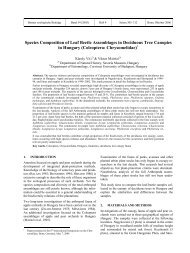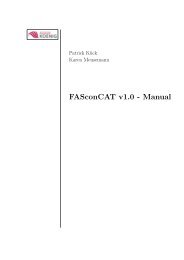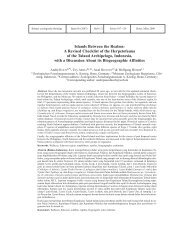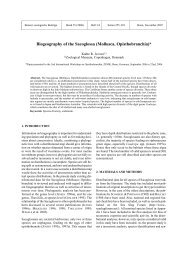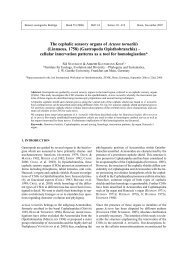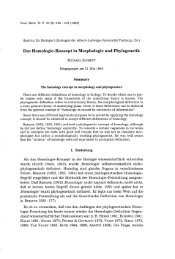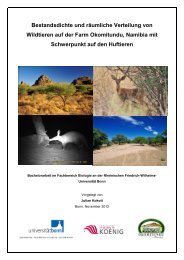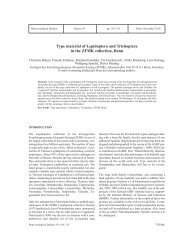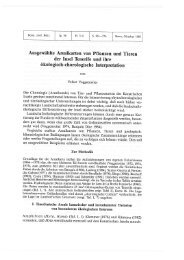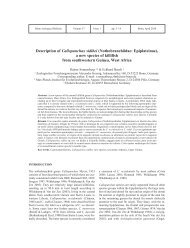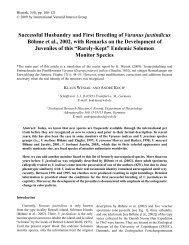Biting Midges of the Genus Palpomyia Meigen (Diptera ...
Biting Midges of the Genus Palpomyia Meigen (Diptera ...
Biting Midges of the Genus Palpomyia Meigen (Diptera ...
- No tags were found...
You also want an ePaper? Increase the reach of your titles
YUMPU automatically turns print PDFs into web optimized ePapers that Google loves.
44 Sujit K. DAS GUPTA et al.: <strong>Biting</strong> <strong>Midges</strong> <strong>of</strong> <strong>the</strong> <strong>Genus</strong> <strong>Palpomyia</strong> <strong>Meigen</strong> in IndiaFig. 1. A–J. <strong>Palpomyia</strong> pseudorivularis sp.n. ?. A) antenna, B) Palpus, C) Mandible, D–F) fore, mid, hind femora and tibiae, G)spines on fore femur, H) hind tibial comb, I) wing, J) sperma<strong>the</strong>cae.
Bonner zoologische Beiträge 56 (2007)45Male with a broad sternite IX, without caudomedianexcavation. Gonostylus slender, with a hooked tip.......................................................... deminutipalpis `4. Mid and hind femora with dark brown apical bands.Mid tibia with one apical spine . . . . . . . . . . . . . . . . 5Mid and hind femora pale, without pigmented bands.Mid tibia without apical spine . . . . . . . . . . . . . . . . . 65. Palpal segment III <strong>of</strong> female with a subapical pitwith two sensillae. Palpal segment V with a long apicalspines ................................................. impli<strong>the</strong>ca ´Palpal segment III <strong>of</strong> female without sensillae. Palpalsegment V with a short subapical spine........................................................ pseudorivularis ´6. Female with inflated forefemur bearing 8–10 ventralspines on entire length ................................. magna ´Forefemur slender in both sexes, with 3 and 4 apicalspines, respectively .................................... stella `, ´7. All femora <strong>of</strong> male armed with stout spines........................................................... *leucopogon `Only fore femora armed with stout spines . . . . . . . . 88. Female thorax shining red, bearing a pair <strong>of</strong> mediolateralspinules ...................................... *himalayae ´Female thorax ei<strong>the</strong>r dark brown or black and devoid<strong>of</strong> spinules . . . . . . . . . . . . . . . . . . . . . . . . . . . . . . . . . 99. Female dark brown with pale halter .. *albiditarsis ´Female with a deep black body and dark brown halter....................................................................*rivularis ´Descriptions <strong>of</strong> <strong>the</strong> species<strong>Palpomyia</strong> crassipalpis Sinha, Das Gupta & Chaudhuri,2003 (SINHA et al. 2003: 75).<strong>Palpomyia</strong> flexidigita Sinha, Das Gupta & Chaudhuri,2003: 79. New synonym.<strong>Palpomyia</strong> novita Saha & Das Gupta, 2005: 63. Newsynonym.´: Unknown.Material: Holotype `, West Bengal, Panagarh AgricultureFarm, 20.vi.1990. leg. P. K. Chaudhuri. 2 `, Durgapur,13.vii.2001, leg D.Sai; 1 `, Asansol, 18.viii.2001, leg.S. Sen.Remarks. SINHA et al. (2003) described <strong>the</strong> species fromIndia. The midges in <strong>the</strong> present study conform fully withthose <strong>of</strong> <strong>the</strong> above authors and <strong>the</strong> holotype <strong>of</strong> P. crassipalpis.After critical study and a comparison <strong>of</strong> <strong>Palpomyia</strong>flexidigita and P. novita with P. crassipalpis it has beenconcluded that <strong>the</strong>se species are synonymous with<strong>Palpomyia</strong> crassipalpis. In this context, it should be notedthat Fig.1 <strong>of</strong> P. crassipalpis was mistakenly printed asFig. 3 <strong>of</strong> Sinha et al. (2003).The species may be diagnosed by <strong>the</strong> following combination<strong>of</strong> character states: short palpal segments, anteriorpart <strong>of</strong> thorax hairy, 5 bristles on <strong>the</strong> scutellum, femorawith dark brown broad apical band, hind tibia darkbrown with pale band at its apical 1/3rd, 5 forefemoralspines, 9 spines <strong>of</strong> hind tibial comb, thumb like hind tibialspur, grayish wing about three times longer than broad,r 2 1.5 times longer than r 1 , aedeagus with longer recurvedbasal arms and slender distal arm, parameres fused andslender gonostylus ending with a bud<strong>Palpomyia</strong> deminutipalpis Sinha, Das Gupta & Chaudhuri,2003 (SINHA et al. 2003: 79).<strong>Palpomyia</strong> barbara Saha & Das Gupta, 2005: 62. Newsynonym.´: Unknown.Material. 3 `, West Bengal, Asansol, 23.vii.2001, leg. G.Bhattacharyay;1 `, Kumardubi, 25.vii.2001, leg. D. Sai.Holotype `, Belpahari, 8.vi.1991, leg. S. Sinha.Remarks. The present specimens conform with those <strong>of</strong>SINHA et al. (2003) in structures and <strong>the</strong> morphometrics.The diagnostic features <strong>of</strong> <strong>the</strong> species are: elongated palpalsegment II with sensory pit, reduced palpal segmentV, scattered hairs and streak on thorax, 7 fore femoralspines, hind tibial comb <strong>of</strong> 7 spines, r 2 little longer thanr 1 , elongated gonocoxite with broad base, short gonostyluswith bud at <strong>the</strong> tip, triangular aedeagus having deepmedian excavation and heavily sclerotized parameres withfused basal armsOn examination <strong>of</strong> <strong>the</strong> types and previous description <strong>of</strong>SINHA et al. (2003), it appears that <strong>Palpomyia</strong> deminutipalpisand <strong>Palpomyia</strong> barbara are <strong>the</strong> same species andP. barbara is proposed as a new synonym <strong>of</strong> <strong>the</strong> formerspecies due to similarities <strong>of</strong> morphological features asstated above.<strong>Palpomyia</strong> magna Tokunaga, 1966(TOKUNAGA 1966: 130).Material: 2 ´, West Bengal, Jorebanglow (2040m),21.vii.2001, leg. U. Majumdar; 1 ´, Tindharia (1320 m)25.vii.2001, leg. S.K. Pradhan.Remarks.TOKUNAGA (1966) described <strong>the</strong> female <strong>of</strong> <strong>the</strong>species from New Guinea. In <strong>the</strong> course <strong>of</strong> <strong>the</strong> presentstudy, three insects <strong>of</strong> <strong>the</strong> Himalayas are identified as conformingfully to <strong>the</strong> description by TOKUNAGA (1966). Thespecies may be diagnosed by: eyes separated as wide asone facet, 12 (6 large and 5 minute) mandibular teeth,scutellum with 4 large and many small bristles, fore femurmostly with 10 spines, hind tibial comb <strong>of</strong> 8 spines,
46 Sujit K. DAS GUPTA et al.: <strong>Biting</strong> <strong>Midges</strong> <strong>of</strong> <strong>the</strong> <strong>Genus</strong> <strong>Palpomyia</strong> <strong>Meigen</strong> in IndiaFig. 2. A–J. <strong>Palpomyia</strong> simpli<strong>the</strong>ca sp.n. ?. A) flagellomeres I–XIII, B) Palpus, C) mandible, D–F) fore, mid , hind femora andtibiae, G) spines on fore femur, H) hind tibial comb, I) wing, J) sperma<strong>the</strong>cae.




